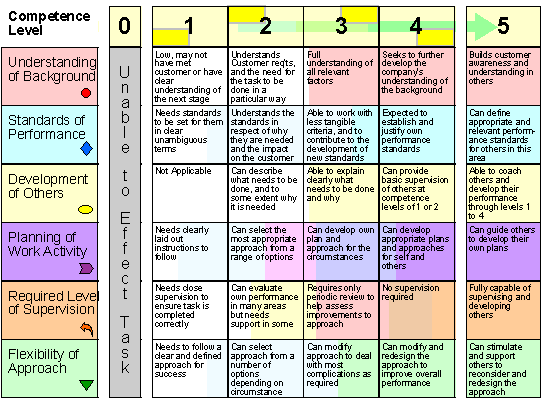|
Teamwork
 As
the company adopts a more systematic approach to the management
of its activities, more and more of your staff will become involved
in the process of management - even if it is only the management
of local improvements. As
the company adopts a more systematic approach to the management
of its activities, more and more of your staff will become involved
in the process of management - even if it is only the management
of local improvements.
Initially not everyone will have
the skills they need for this task, but teamwork provides an
excellent opportunity both to combine the skills they do have,
and to actively develop those they don't.
But for teamwork to be truly
effective in both of these tasks it is not enough to throw together
a group of people and expect them to get on with task - the task
may well get done, but it is unlikely to be done in the most
efficient or effective manner, and many of the opportunities
of using the challenge to develop the capabilities of your people
will be lost.
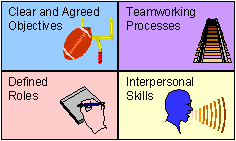 Teams
need to be set up properly if they are to fulfil the opportunities
they have. Setting up a team involves ensuring that the four
elements of teamwork are properly in place (see diagram right). Teams
need to be set up properly if they are to fulfil the opportunities
they have. Setting up a team involves ensuring that the four
elements of teamwork are properly in place (see diagram right).
Firstly, the team needs to develop
a consistent and shared view of the objectives. Secondly, the
team needs to decide and agree on a practical process to pursue
those objectives. Thirdly, the team needs to have established
the roles and responsibilities of each of the team members in
working through that process, and any essential support to it.
And fourthly, the team needs to have an agreed way of working
together so that ideas and communication do not become distorted
by inappropriate responses or misinterpretation.
These things have to be put in
place from the outset, although they may at times be temporary,
or may need to be reviewed as the task becomes clearer. If the
team is unable to do this for itself they made need to involve
a 'facilitator' who can help them through it and ensure the quality
of the four elements is maintained throughout the life of the
team.
This may be especially valuable
during the early stages of teamwork. Teams tend to progress through
a number of stages in their development - a polite and careful
phase called 'Forming', a challenging phase called 'Storming',
an adjusting and accommodating phase called 'Norming' and finally
into 'Performing' (see diagram in top left corner). Focusing
on the four elements of teamwork will ensure a healthy progress
through these phases. When something goes wrong with the teamwork
it can always be related back to one or more of the four elements.
If these things are attended
to properly, the team environment will prove an excellent mechanism
for both growing your performance and your people. And teams
can be established to undertake any task, from agreeing how to
organise a coffee break, through to running the company itself.
[Return
to Top of Page]
Training
 The
adoption of a systematic approach places new demands on people.
Demands for which they are not always well equipped. The
adoption of a systematic approach places new demands on people.
Demands for which they are not always well equipped.
Training provides an effective
means to equip people for their role, to provide them with confidence
to undertake it, and to give them a common language to share
experience with their colleagues.
Training to be considered in
ensuring your people are so equipped would include: training
in teamwork and team processes; training in interpersonal and
influencing skills; training in personal responsibility; and
training in facilitation skills for those required to coach and
support their colleagues as they adopt the new approach.
[Return
to Top of Page]
Empowerment
 Empowerment
is a concept that is often misunderstood. Some see it as a democratisation
of the management process - a handing over of rights to the previously
disenfranchised. Some see it as an abdication of responsibility. Empowerment
is a concept that is often misunderstood. Some see it as a democratisation
of the management process - a handing over of rights to the previously
disenfranchised. Some see it as an abdication of responsibility.
Empowerment is essentially the
provision of the ability to influence of control those things
which affect the quality of our work. The granting of authority
is only part of it - the main part concerns the development of
skills, the provision of resources and facilities, and the coaching
of understanding.
Empowerment is about growing
the ability to respond, and then formalising the 'authority'
that matches that ability - not the other way round. Empowerment
is first and foremost about developing the potential of your
people, and only then is it about delegating your authority.
However, empowerment is a key
feature of establishing a systematic approach to management.
It is essential that people grow to take responsibility for improving
and managing the performance of the processes that they operate.
But empowerment is a process, and only at the end of the process
is the full authority conferred.
The following checklist may help
you think through the responsibilities a manager has if he/she
is to empower a subordinate to take responsibility for a task:
Ensuring (but not necessarily
providing):
Clarity
of what is to be achieved and why
A process which is capable of meeting this
The skills and motivation to effect the process
Facility to effect the process
Visibility of risks and deficiencies
The means to manage such problems effectively |
[Return
to Top of Page]
Self Managed
Workgroups
 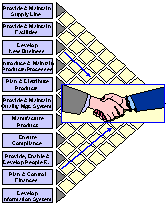 Self managed work groups (SMWGs)
are in many ways an extension of the concept of empowerment.
In an SMWG not only is full responsibility of the task delegated
to the team, but the team are also given responsibility for those
management activities that concern the maintenance and development
of the team. Self managed work groups (SMWGs)
are in many ways an extension of the concept of empowerment.
In an SMWG not only is full responsibility of the task delegated
to the team, but the team are also given responsibility for those
management activities that concern the maintenance and development
of the team.
In an SMWG the team take decisions
on its own recruitment, training, organisation, and sometimes
even its working hours and remuneration. SMWGs can be very effective
in the right circumstances - and they can have the motivating
factor of the team in a very real sense 'running its own business'.
However the responsibilities of empowerment
are key to setting an SMWG up effectively - for all the
roles the team is expected to undertake.
A useful device for SMWGs in
understanding their role with regard to other groups and the
other parts of the business, is the roof of the QFD (see Philosophy).
In working through the potential for the SMWG to support or conflict
with other groups, the roof provides a means for them to think
through what communication they will require.
[Return
to Top of Page]
Meeting
Analysis
 Most
of management takes place in meetings - whether those meetings
are full blown formal whole-day affairs, or whether they are
a simple interchange between two people. Our effectiveness in
meetings is in large part our effectiveness in management. Most
of management takes place in meetings - whether those meetings
are full blown formal whole-day affairs, or whether they are
a simple interchange between two people. Our effectiveness in
meetings is in large part our effectiveness in management.
Because of this, strategies to
reduce the number of meetings are often doomed to failure - the
goal must surely be to have meetings that are more efficient,
more appropriately attended, and better run.
One way of achieving this is
to review each meeting in order that future meetings can be improved.
Such a review need not be complex, and generally we would favour
a simple analysis of 'what went well?' and 'room for improvement'
listed on a flipchart by the group at the end of the meeting.
The flipchart can then be revisited at the start of the next
meeting in order that the mistakes are not repeated.
The quality of this review can
be helped by prominently displaying the criteria that represents
good meeting discipline in each meeting room. This will both
guide behaviours in the meeting and ensure a more comprehensive
review.
[Return
to Top of Page]
Survey
 Surveys
are a very useful mechanism of evaluating the companies performance
in all areas of PEOPLE. Designed appropriately, then can provide
feedback on the effectiveness of empowerment, the quality of
meetings, how well teamwork works, management style, the value
of training, and on the deployment of every aspect of the management
process. An example of a possible survey is included in the resources section. Surveys
are a very useful mechanism of evaluating the companies performance
in all areas of PEOPLE. Designed appropriately, then can provide
feedback on the effectiveness of empowerment, the quality of
meetings, how well teamwork works, management style, the value
of training, and on the deployment of every aspect of the management
process. An example of a possible survey is included in the resources section.
Typically a company would undertake
a comprehensive survey of its people's perceptions on an annual
basis, and feed this into a cycle of improvement planning. But
simpler, shorter surveys can be used on a sampled basis on a
monthly cycle for those aspects that management wants to keep
a tight control of through the general management process.
[Return
to Top of Page]
Competence
Planning
 Competence
is essentially the link that channels your resources to meet
the opportunities that exist around you (see diagram on the left
- source Martin Price). Competence
is essentially the link that channels your resources to meet
the opportunities that exist around you (see diagram on the left
- source Martin Price).
As such Competence is essentially
a strategic tool, and needs to be thought through accordingly.
This is a long way removed from the traditional focus that competence
is what we need to get the job done - it moves Competence as
a concept from a reactive disposition to a proactive one.
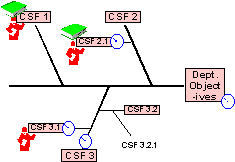 One
tool that helps this thinking is to use a modified form of an
Ishikawa diagram. By putting the strategic objective or opportunity
at the head of the diagram, and the Critical Success Factors
for fulfilling that opportunity on the legs of the diagram, it
is possible to explore a number of things. One
tool that helps this thinking is to use a modified form of an
Ishikawa diagram. By putting the strategic objective or opportunity
at the head of the diagram, and the Critical Success Factors
for fulfilling that opportunity on the legs of the diagram, it
is possible to explore a number of things.
In the diagram on the right we
illustrate the use of this model to identify the measures that
management need to establish as part of their management routine
(blue dials), the responsibilities they need to define for people
within the process (red men) and the competence development that
will be needed for these people to fulfil those critical roles
(green books)
[Return
to Top of Page]
Training
and Development as a Process
 Training
and Development is a process, and not a response. Training and
Development is also something that only happens in small part
within formal training courses. Training
and Development is a process, and not a response. Training and
Development is also something that only happens in small part
within formal training courses.
Most training takes place (effectively
or ineffectively) at the actual place of work.
A manager's role is two-fold:
deliver improved performance today, and deliver the potential
for improved performance tomorrow. But it is often the second
bit that gets forgotten.
Each task or activity has the
potential to contribute to both aspects of the manager's role.
The process for thinking through the first part is often clear
- but there is often no process for thinking through the second
part.
The diagram below is one model
for helping Manager's to think through this more clearly. |
 People
People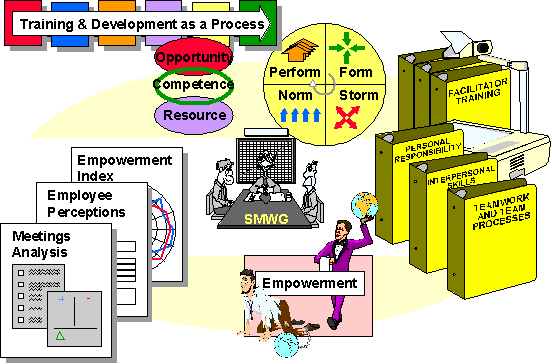
 As
the company adopts a more systematic approach to the management
of its activities, more and more of your staff will become involved
in the process of management - even if it is only the management
of local improvements.
As
the company adopts a more systematic approach to the management
of its activities, more and more of your staff will become involved
in the process of management - even if it is only the management
of local improvements. Teams
need to be set up properly if they are to fulfil the opportunities
they have. Setting up a team involves ensuring that the four
elements of teamwork are properly in place (see diagram right).
Teams
need to be set up properly if they are to fulfil the opportunities
they have. Setting up a team involves ensuring that the four
elements of teamwork are properly in place (see diagram right). The
adoption of a systematic approach places new demands on people.
Demands for which they are not always well equipped.
The
adoption of a systematic approach places new demands on people.
Demands for which they are not always well equipped. Empowerment
is a concept that is often misunderstood. Some see it as a democratisation
of the management process - a handing over of rights to the previously
disenfranchised. Some see it as an abdication of responsibility.
Empowerment
is a concept that is often misunderstood. Some see it as a democratisation
of the management process - a handing over of rights to the previously
disenfranchised. Some see it as an abdication of responsibility.
 Self managed work groups (SMWGs)
are in many ways an extension of the concept of empowerment.
In an SMWG not only is full responsibility of the task delegated
to the team, but the team are also given responsibility for those
management activities that concern the maintenance and development
of the team.
Self managed work groups (SMWGs)
are in many ways an extension of the concept of empowerment.
In an SMWG not only is full responsibility of the task delegated
to the team, but the team are also given responsibility for those
management activities that concern the maintenance and development
of the team. Most
of management takes place in meetings - whether those meetings
are full blown formal whole-day affairs, or whether they are
a simple interchange between two people. Our effectiveness in
meetings is in large part our effectiveness in management.
Most
of management takes place in meetings - whether those meetings
are full blown formal whole-day affairs, or whether they are
a simple interchange between two people. Our effectiveness in
meetings is in large part our effectiveness in management. Surveys
are a very useful mechanism of evaluating the companies performance
in all areas of PEOPLE. Designed appropriately, then can provide
feedback on the effectiveness of empowerment, the quality of
meetings, how well teamwork works, management style, the value
of training, and on the deployment of every aspect of the management
process. An example of a possible survey is included in the
Surveys
are a very useful mechanism of evaluating the companies performance
in all areas of PEOPLE. Designed appropriately, then can provide
feedback on the effectiveness of empowerment, the quality of
meetings, how well teamwork works, management style, the value
of training, and on the deployment of every aspect of the management
process. An example of a possible survey is included in the  Competence
is essentially the link that channels your resources to meet
the opportunities that exist around you (see diagram on the left
- source Martin Price).
Competence
is essentially the link that channels your resources to meet
the opportunities that exist around you (see diagram on the left
- source Martin Price). One
tool that helps this thinking is to use a modified form of an
Ishikawa diagram. By putting the strategic objective or opportunity
at the head of the diagram, and the Critical Success Factors
for fulfilling that opportunity on the legs of the diagram, it
is possible to explore a number of things.
One
tool that helps this thinking is to use a modified form of an
Ishikawa diagram. By putting the strategic objective or opportunity
at the head of the diagram, and the Critical Success Factors
for fulfilling that opportunity on the legs of the diagram, it
is possible to explore a number of things. Training
and Development is a process, and not a response. Training and
Development is also something that only happens in small part
within formal training courses.
Training
and Development is a process, and not a response. Training and
Development is also something that only happens in small part
within formal training courses.